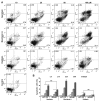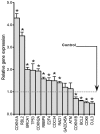Genistein induces G2/M cell cycle arrest and apoptosis via ATM/p53-dependent pathway in human colon cancer cells
- PMID: 23686257
- PMCID: PMC3742162
- DOI: 10.3892/ijo.2013.1946
Genistein induces G2/M cell cycle arrest and apoptosis via ATM/p53-dependent pathway in human colon cancer cells
Abstract
Soybean isoflavones have been used as a potential preventive agent in anticancer research for many years. Genistein is one of the most active flavonoids in soybeans. Accumulating evidence suggests that genistein alters a variety of biological processes in estrogen-related malignancies, such as breast and prostate cancers. However, the molecular mechanism of genistein in the prevention of human colon cancer remains unclear. Here we attempted to elucidate the anticarcinogenic mechanism of genistein in human colon cancer cells. First we evaluated the growth inhibitory effect of genistein and two other isoflavones, daidzein and biochanin A, on HCT-116 and SW-480 human colon cancer cells. In addition, flow cyto-metry was performed to observe the morphological changes in HCT-116/SW-480 cells undergoing apoptosis or cell cycle arrest, which had been visualized using Annexin V-FITC and/or propidium iodide staining. Real-time PCR and western blot analyses were also employed to study the changes in expression of several important genes associated with cell cycle regulation. Our data showed that genistein, daidzein and biochanin A exhibited growth inhibitory effects on HCT-116/SW-480 colon cancer cells and promoted apoptosis. Genistein showed a significantly greater effect than the other two compounds, in a time- and dose-dependent manner. In addition, genistein caused cell cycle arrest in the G2/M phase, which was accompanied by activation of ATM/p53, p21waf1/cip1 and GADD45α as well as downregulation of cdc2 and cdc25A demonstrated by q-PCR and immunoblotting assay. Interestingly, genistein induced G2/M cell cycle arrest in a p53-dependent manner. These findings exemplify that isoflavones, especially genistein, could promote colon cancer cell growth inhibition and facilitate apoptosis and cell cycle arrest in the G2/M phase. The ATM/p53-p21 cross-regulatory network may play a crucial role in mediating the anticarcinogenic activities of genistein in colon cancer.
Figures






Similar articles
-
Anti-Colon Cancer Effects of 6-Shogaol Through G2/M Cell Cycle Arrest by p53/p21-cdc2/cdc25A Crosstalk.Am J Chin Med. 2015;43(4):743-56. doi: 10.1142/S0192415X15500469. Epub 2015 Jun 28. Am J Chin Med. 2015. PMID: 26119958
-
Novel herbal flavonoids promote apoptosis but differentially induce cell cycle arrest in human colon cancer cell.Invest New Drugs. 2010 Feb;28(1):1-13. doi: 10.1007/s10637-008-9207-3. Epub 2009 Jan 13. Invest New Drugs. 2010. PMID: 19139819
-
Effects of soy isoflavones on apoptosis induction and G2-M arrest in human hepatoma cells involvement of caspase-3 activation, Bcl-2 and Bcl-XL downregulation, and Cdc2 kinase activity.Nutr Cancer. 2003;45(1):113-23. doi: 10.1207/S15327914NC4501_13. Nutr Cancer. 2003. PMID: 12791511
-
Genistein: A Potent Anti-Breast Cancer Agent.Curr Issues Mol Biol. 2021 Oct 10;43(3):1502-1517. doi: 10.3390/cimb43030106. Curr Issues Mol Biol. 2021. PMID: 34698063 Free PMC article. Review.
-
Alkaloids and Colon Cancer: Molecular Mechanisms and Therapeutic Implications for Cell Cycle Arrest.Molecules. 2022 Jan 28;27(3):920. doi: 10.3390/molecules27030920. Molecules. 2022. PMID: 35164185 Free PMC article. Review.
Cited by
-
Computational Biology Dynamics of Mps1 Kinase Molecular Interactions with Isoflavones Reveals a Chemical Scaffold with Potential to Develop New Therapeutics for the Treatment of Cancer.Int J Mol Sci. 2022 Nov 17;23(22):14228. doi: 10.3390/ijms232214228. Int J Mol Sci. 2022. PMID: 36430712 Free PMC article.
-
GEN-27, a Newly Synthetic Isoflavonoid, Inhibits the Proliferation of Colon Cancer Cells in Inflammation Microenvironment by Suppressing NF-κB Pathway.Mediators Inflamm. 2016;2016:2853040. doi: 10.1155/2016/2853040. Epub 2016 Feb 23. Mediators Inflamm. 2016. PMID: 27057094 Free PMC article.
-
Genistein and Ascorbic Acid Reduce Oxidative Stress-Derived DNA Damage Induced by the Antileishmanial Meglumine Antimoniate.Antimicrob Agents Chemother. 2018 Aug 27;62(9):e00456-18. doi: 10.1128/AAC.00456-18. Print 2018 Sep. Antimicrob Agents Chemother. 2018. PMID: 29941649 Free PMC article.
-
Unraveling the in vitro antitumor activity of Vismia baccifera against HepG2: role of hydrogen peroxide.Heliyon. 2018 Jun 29;4(6):e00675. doi: 10.1016/j.heliyon.2018.e00675. eCollection 2018 Jun. Heliyon. 2018. PMID: 30003166 Free PMC article.
-
Soy Isoflavone Genistein-Mediated Downregulation of miR-155 Contributes to the Anticancer Effects of Genistein.Nutr Cancer. 2016;68(1):154-64. doi: 10.1080/01635581.2016.1115104. Epub 2016 Jan 15. Nutr Cancer. 2016. PMID: 26771440 Free PMC article.
References
-
- Arber N, Levin B. Chemoprevention of colorectal cancer: ready for routine use? Recent Results Cancer Res. 2005;166:213–230. - PubMed
-
- Rodriguez M, Du GJ, Wang CZ, Yuan CS. Letter to the editor: Panaxadiol’s anticancer activity is enhanced by epicatechin. Am J Chin Med. 2010;38:1233–1235. - PubMed
-
- Jemal A, Siegel R, Ward E, Hao Y, Xu J, Thun MJ. Cancer statistics, 2009. CA Cancer J Clin. 2009;59:225–249. - PubMed
-
- Wils J, O’Dwyer P, Labianca R. Adjuvant treatment of colorectal cancer at the turn of the century: European and US perspectives. Ann Oncol. 2001;12:13–22. - PubMed
-
- Segal NH, Saltz LB. Evolving treatment of advanced colon cancer. Annu Rev Med. 2009;60:207–219. - PubMed
Publication types
MeSH terms
Substances
Grants and funding
LinkOut - more resources
Full Text Sources
Other Literature Sources
Research Materials
Miscellaneous

